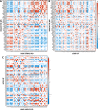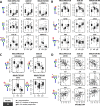High-throughput Serum N-Glycomics: Method Comparison and Application to Study Rheumatoid Arthritis and Pregnancy-associated Changes
- PMID: 30242110
- PMCID: PMC6317482
- DOI: 10.1074/mcp.RA117.000454
High-throughput Serum N-Glycomics: Method Comparison and Application to Study Rheumatoid Arthritis and Pregnancy-associated Changes
Abstract
N-Glycosylation is a fundamentally important protein modification with a major impact on glycoprotein characteristics such as serum half-life and receptor interaction. More than half of the proteins in human serum are glycosylated, and the relative abundances of protein glycoforms often reflect alterations in health and disease. Several analytical methods are currently capable of analyzing the total serum N-glycosylation in a high-throughput manner.Here we evaluate and compare the performance of three high-throughput released N-glycome analysis methods. Included were hydrophilic-interaction ultra-high-performance liquid chromatography with fluorescence detection (HILIC-UHPLC-FLD) with 2-aminobenzamide labeling of the glycans, multiplexed capillary gel electrophoresis with laser-induced fluorescence detection (xCGE-LIF) with 8-aminopyrene-1,3,6-trisulfonic acid labeling, and matrix-assisted laser desorption/ionization time-of-flight mass spectrometry (MALDI-TOF-MS) with linkage-specific sialic acid esterification. All methods assessed the same panel of serum samples, which were obtained at multiple time points during the pregnancies and postpartum periods of healthy women and patients with rheumatoid arthritis (RA). We compared the analytical methods on their technical performance as well as on their ability to describe serum protein N-glycosylation changes throughout pregnancy, with RA, and with RA disease activity.Overall, the methods proved to be similar in their detection and relative quantification of serum protein N-glycosylation. However, the non-MS methods showed superior repeatability over MALDI-TOF-MS and allowed the best structural separation of low-complexity N-glycans. MALDI-TOF-MS achieved the highest throughput and provided compositional information on higher-complexity N-glycans. Consequentially, MALDI-TOF-MS could establish the linkage-specific sialylation differences within pregnancy and RA, whereas HILIC-UHPLC-FLD and xCGE-LIF demonstrated differences in α1,3- and α1,6-branch galactosylation. While the combination of methods proved to be the most beneficial for the analysis of total serum protein N-glycosylation, informed method choices can be made for the glycosylation analysis of single proteins or samples of varying complexity.
Keywords: Chromatography; Electrophoresis; Glycomics; Glycosylation; High Throughput Screening; Mass Spectrometry; Plasma or Serum Analysis; Pregnancy; Rheumatoid Arthritis.
© 2019 by The American Society for Biochemistry and Molecular Biology, Inc.
Conflict of interest statement
Competing financial interest: Richard Gardner, Archana Shubhakar, Daniel I. Spencer, and Daryl L. Fernandes are employed at Ludger, Ltd., Gordan Lauc is the owner and Irena Trbojević-Akmačić and Maja Pučić-Baković are employees of Genos Glycoscience Research Laboratory, and René Hennig and Erdmann Rapp are employed at glyXera GmbH, all of which perform commercial glycosylation analysis. Karli R. Reiding and Manfred Wuhrer are inventors of IP licensed to Ludger, Ltd. and glyXera GmbH
Figures



References
-
- Rouwendal G. J., van der Lee M. M., Meyer S., Reiding K. R., Schouten J., de Roo G., Egging D. F., Leusen J. H., Boross P., Wuhrer M., Verheijden G. F., Dokter W. H., Timmers M., and Ubink R. (2016) A comparison of anti-HER2 IgA and IgG1 in vivo efficacy is facilitated by high N-glycan sialylation of the IgA. mAbs 8, 74–86 - PMC - PubMed
-
- Oh M. J., Hua S., Kim B. J., Jeong H. N., Jeong S. H., Grimm R., Yoo J. S., and An H. J. (2013) Analytical platform for glycomic characterization of recombinant erythropoietin biotherapeutics and biosimilars by MS. Bioanalysis 5, 545–559 - PubMed
Publication types
MeSH terms
Substances
LinkOut - more resources
Full Text Sources
Other Literature Sources
Medical

